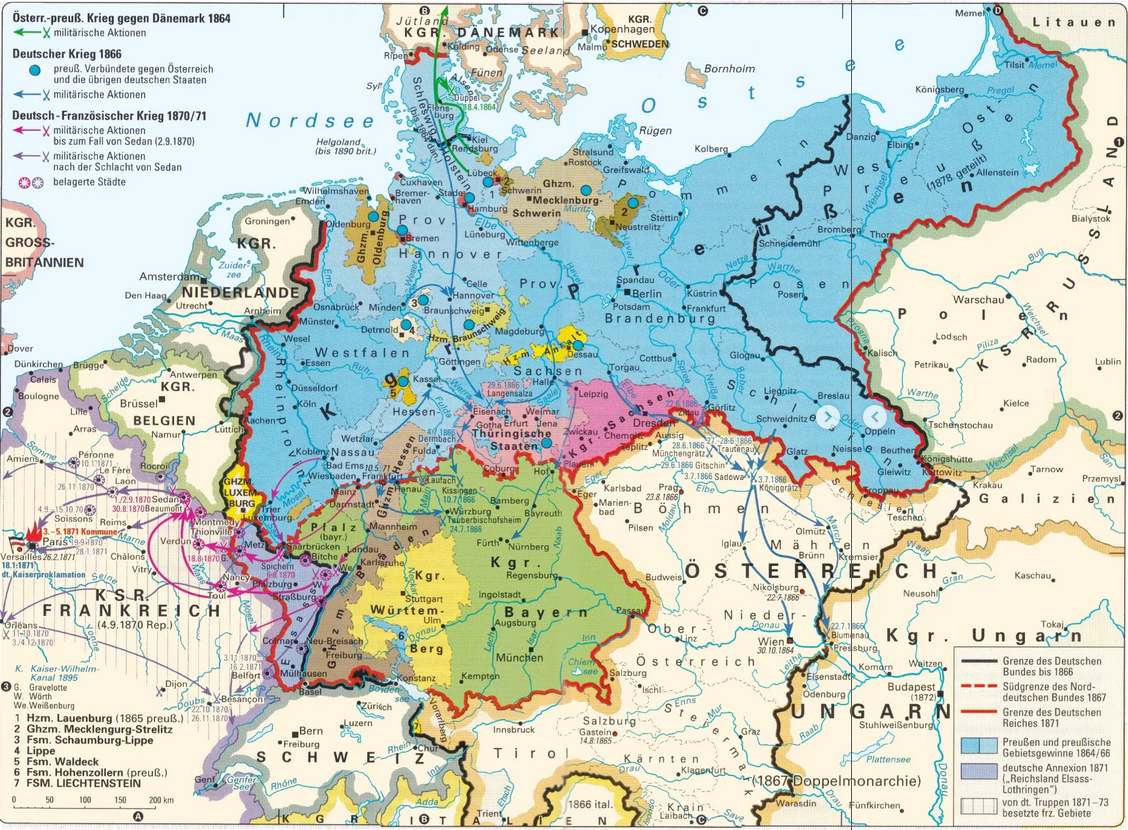Map of the Three Wars of German Unification


David Chen
Data Visualization Specialist
David Chen is an expert in transforming complex geographic datasets into compelling visual narratives. He combines his background in computer science ...
Geographic Analysis
What This Map Shows
This map illustrates the three significant wars that led to the unification of the German Empire in the 19th century: the Danish War (1864), the Austro-Prussian War (1866), and the Franco-Prussian War (1870-1871). Each of these conflicts played a crucial role in shaping the political landscape of Central Europe and ultimately led to the establishment of a united Germany under Prussian leadership. The map delineates the territories involved, the key battles fought, and the political boundaries that were redrawn in the aftermath of each conflict.
Deep Dive into the Wars of Unification
The path to German unification was not a straightforward one; it was marked by a series of wars that reflected the complex political and social dynamics of 19th-century Europe. The Danish War, the first of the three, was fought over the duchies of Schleswig and Holstein. Prussia and Austria allied against Denmark, resulting in a swift victory that expanded their influence in the region. Interestingly, this war set the stage for future conflicts by highlighting the growing tensions between Prussia and Austria over the leadership of the German states.
The Austro-Prussian War, also known as the Seven Weeks' War, was a pivotal moment in the unification process. In 1866, Prussia sought to exclude Austria from German affairs, leading to a decisive conflict. The Prussian military, equipped with the new needle gun, achieved a series of quick victories, culminating in the Battle of Königgrätz. This war effectively marked the decline of Austrian power in Germany, allowing Prussia to establish the North German Confederation, thereby uniting a significant portion of the German states under its leadership.
Finally, the Franco-Prussian War ignited nationalistic fervor among the German states. In 1870, France declared war on Prussia, which united the German states against a common enemy. The war ended with the capture of Paris and the declaration of the German Empire in the Hall of Mirrors at Versailles in 1871. This event not only solidified Prussian dominance but also ignited a sense of national identity among the German people, which had lasting implications for Europe.
These wars were not merely military confrontations; they were also deeply intertwined with the rise of nationalism and the decline of old empires. The unification of Germany under Prussian leadership marked the beginning of a new era in European politics, characterized by the emergence of Germany as a major power.
Regional Analysis
Examining the regions involved in these conflicts reveals stark contrasts in political and military strategies. In the north, Prussia's efficient military organization and innovative tactics set it apart from its rivals. The map highlights key locations like Schleswig, Holstein, and the various battlefields of the Austro-Prussian War, illustrating the geographic significance of these areas in the unification process.
In contrast, Austria's dominance in the south was challenged by the rise of Prussia. The southern German states, such as Bavaria, had their unique interests and were initially hesitant about unification under Prussian rule. However, the shared experience of the Franco-Prussian War fostered a sense of unity that transcended regional loyalties, culminating in the establishment of a unified German Empire.
Interestingly, the map also showcases the shifting boundaries and the impact of these wars on various territories. For example, the annexation of Alsace-Lorraine after the Franco-Prussian War not only altered the borders but also sowed the seeds of future conflicts between Germany and France.
Significance and Impact
The significance of the wars of unification extends far beyond the immediate outcomes of military victories. The creation of the German Empire fundamentally altered the balance of power in Europe, leading to increased tensions that would later contribute to the outbreak of World War I. The rise of a powerful Germany fostered both admiration and resentment among its neighbors, shaping diplomatic relations for decades to come.
Today, the legacy of these wars can still be felt in contemporary European politics. National boundaries, identities, and alliances were all profoundly influenced by the events depicted in this map. Understanding the history of German unification provides valuable insights into current geopolitical dynamics and the continuing evolution of national identities in Europe.
As we reflect on these historical conflicts, we can see how the map serves as a reminder of the complexities of nation-building and the enduring impact of war on national identity. Have you ever wondered how much the landscape of Europe has changed since these pivotal conflicts? The implications of the three wars of unification resonate in today's discussions about nationalism and regional unity across the continent.
Visualization Details
- Published
- October 17, 2025
- Views
- 22
Comments
Loading comments...